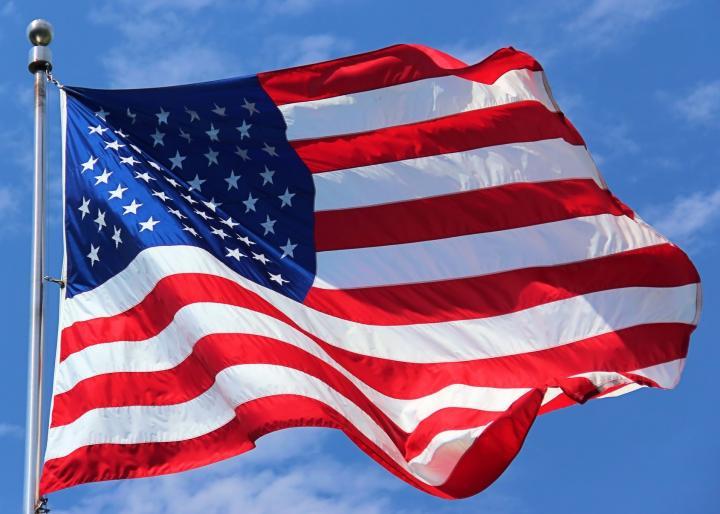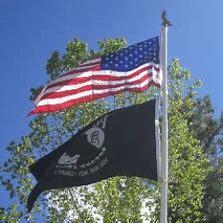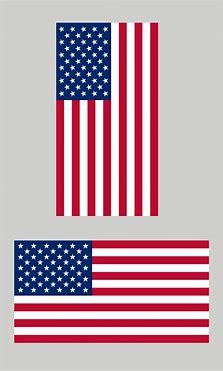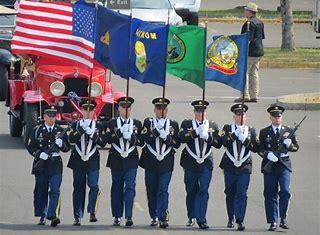Civics Sunday - Flag Day
Publishers' Note: Recently we asked what additional topics should be included in the Civics Sunday series. One of the first ideas was related to 'flag etiquette." As with so many things - timing is everything! We have included, Flag Day, flag history, proper respect, and proper display - just in time for Flag Day, our Nation's birthday, and all the other events that proudly 'show our colors.'

Flag Day
In the United States, Flag Day is celebrated on June 14. It commemorates the adoption of the flag of the United States on June 14, 1777 by resolution of the Second Continental Congress.
Since 1916 we have set aside June 14th as National Flag Day in honor of the adoption of the Stars and Stripes as the official American flag.
Many towns have Flag Day parades and other observances. This year, on Flag Day, observances are planned at Placentino and Miller schools.

The Flag as a Symbol of our Nation Through the Years
The American flag unites us as a country and represents what our country was built on: liberty and freedom.
The history of our flag began during our Revolutionary War. In June 1776, Betsy Ross, a seamstress who made clothes for George Washington, was asked by the General to make the first American flag. The colors chosen for our national symbol: red, white and blue, were chosen to represent valor (red), liberty and purity (white), and justice and loyalty (blue).
Francis Scott Key wrote the lyrics to our national anthem after he witnessed the British attack at Fort McHenry. He watched the British ‘rockets’ red glare, the bombs bursting in air,’ yet still saw ‘that star-spangled banner yet wave o’er the land of the free and the home of the brave.’
The American flag was nicknamed Old Glory during our nation’s Civil War.
There have been 27 official versions of the American flag, each with a different number of stars. All versions should be treated with the same respect.
Today, there are 50 stars and 13 stripes on the American flag. The 50 stars represent each of the states in the U.S. and the 13 stripes represent the original 13 colonies that became the first states in the Union.

Respecting the Flag / National Anthem
Showing proper respect for the American Flag is governed by the US Flag Code and several military manuals. Civilians can find all the guidelines related to our flag at US Flag Code – including when the flag has been ordered to half-staff (half-mast for the Navy). Here is an excerpt from the Code that covers proper respect for our nation’s flag.
“Saluting the Flag
When the flag passes in a procession, or when it is hoisted or lowered, all should face the flag and salute.
The Salute
To salute, all persons stand up. Those in uniform give the appropriate formal salute. Citizens not in uniform salute by placing their right hand over the heart and all with head cover should remove it and hold it to left shoulder, hand over the heart.
The Pledge of Allegiance and National Anthem
The pledge of allegiance should be rendered by standing, facing the flag, and saluting / hand over the heart.
When the national anthem is played or sung, citizens should stand and salute at the first note and hold the salute through the last note. The salute is directed to the flag, if displayed, otherwise to the music.
STANDARDS of RESPECT
The Flag Code, which formalizes and unifies the traditional ways in which we give respect to the flag, also contains specific instructions on how the flag is not to be used. They are:
- The flag should never be dipped to any person or thing. It is flown upside down only as a distress signal.
- The flag should not be used as a drapery, or for covering a speaker’s desk, draping a platform, or for any decoration in general. Bunting of blue, white and red stripes is available for these purposes. The blue stripe of the bunting should be on the top.
- The flag should never be used for any advertising purpose. It should not be embroidered, printed or otherwise impressed on such articles as cushions, handkerchiefs, napkins, boxes, or anything intended to be discarded after temporary use. Advertising signs should not be attached to the staff or halyard
- The flag should not be used as part of a costume or athletic uniform, except that a flag patch may be used on the uniform of military personnel, fireman, policeman and members of patriotic organizations.
- The flag should never have placed on it, or attached to it, any mark, insignia, letter, word, number, figure, or drawing of any kind.
- The flag should never be used as a receptacle for receiving, holding, carrying, or delivering anything.
When a flag is so worn it is no longer fit to serve as a symbol of our country, it should be destroyed by burning in a dignified manner.
Note: Most American Legion Posts regularly conduct a dignified flag burning ceremony, often on Flag Day, June 14th. Many Cub Scout Packs, Boy Scout Troops, and Girl Scout Troops retire flags regularly as well. Contact your local American Legion Hall or Scout Troop to inquire about the availability of this service.“

Properly Displaying and Presenting the American Flag
The proper display of the American Flag is also governed by the US Flag Code US Flag Code Here is an excerpt from the Code that covers proper display / presentation of our nation’s flag.
“Displaying the Flag Outdoors


When the flag is displayed from a staff projecting from a window, balcony, or a building, the union should be at the peak of the staff unless the flag is at half-staff.

When it is displayed from the same flagpole with another flag - of a state, community, society or Scout unit - the flag of the United States must always be at the top.
When the flag is displayed over a street, it should be hung vertically, with the union to the north or east. If the flag is suspended over a sidewalk, the flag's union should be farthest from the building.
When flown with flags of states, communities, or societies on separate flag poles which are of the same height and in a straight line, the flag of the United States is always placed in the position of honor - to its own right. (This is best understood if one pictures themselves as the flag facing the audience. No other flag should be positioned to your right.) The other flags may be smaller, but none may be larger. No other flag ever should be placed above it. The flag of the United States is always the first flag raised and the last to be lowered.
When flown with the national banner of other countries, each flag must be displayed from a separate pole of the same height. Each flag should be the same size. They should be raised and lowered simultaneously. The flag of one nation may not be displayed above that of another nation.
Displaying the Flag Indoors
When on display, the flag is accorded the place of honor, always positioned to its own right (see above). Place it to the right of the speaker or staging area or sanctuary. Other flags should be to the left.
The flag of the United States of America should be at the center and at the highest point of the group when a number of flags of states, localities, or societies are grouped for display.
When one flag is used with the flag of the United States of America and the staffs are crossed, the flag of the United States is placed on its own right with its staff in front of the other flag.

When displaying the flag against a wall, vertically or horizontally, the flag's union (stars) should be at the top, to the flag's own right, and to the observer's left.
Parading the Flag
When carried in a procession, the flag should be to the right of the marchers. When other flags are carried, the flag of the United States may be centered in front of the others or carried to their right. “


For additional images of how to properly display ‘Old Glory.’ U.S. Flag Display Guidelines
At one level, our flag is a piece of fabric, and the more you know about it, the more you come to appreciate the symbolism and the level of respect it deserves.

Wonderful job. A great number of Americans do not know this. A few years ago the Congress passed a law allowing veterans to use hand salutes for passing flags and flag ceremony's, in civilian cloths and hat or no hat. Thank you again for a great job.
Henry Dellicker | 2019-06-09 08:55:29